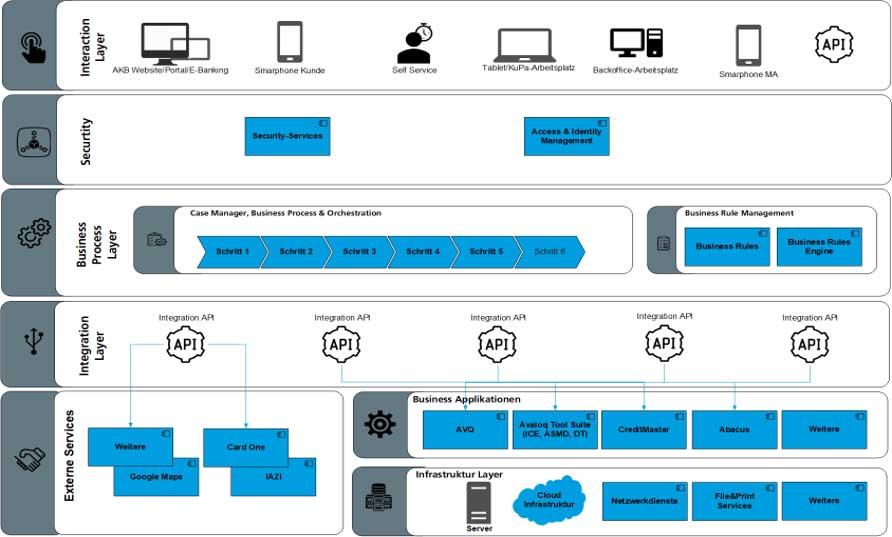Open banking via API has been both an opportunity and a compliance challenge since PSD2 came into force in Europe. New revenue channels hold immense potential, but compliance is complex. Established banks are given the opportunity to establish ecosystems with the help of API connectivity in order to offer their customers interesting services in the future and to contact them in new ways.
by Roger Böhlen, Head of Application & Integration at Aargauische Kantonalbank (AKB)
Classic banks are under a lot of pressure when it comes to money transactions. Because Google, Amazon, Facebook and Apple (GAFA) are pushing forward with transfers via messaging or app and the approval of merchant credits into business areas that were previously reserved for traditional banks. The PSD2 regulations oblige banks to offer external interfaces to process services such as payment initiation services, account information services and payment cards.Open data exchange via APIs
The focus here is on increased open data exchange between financial institutions. It is made possible by the effective use of APIs. These are the point of contact between the bank as a platform and a broad ecosystem. But not only in Germany and the EU, also in Switzerland people are working on APIs and interfaces for new services. Such as the Aargauische Kantonalbank (AKB, website). Private customers can pay with the AKB, take out financing, make investments or save and create pension plans. The Swiss bank offers business customers a comprehensive range of services for everything to do with payments, investments and financing, as well as provision, founding and succession.
Like all banks, AKB and its 800 employees have embarked on a journey into the world of digitization. After all, new contact channels and services hold immense potential.
In 2016/2017, AKB started to take the first steps in the API economy and build a customer platform. However, IT had to realize relatively quickly that there was no integration platform for the relevant data in the Avaloq core banking system. For every digitized solution that was developed and implemented, IT had to re-export the same data over and over again. A total of 20 digitization projects, including financing advice and customer advice, were on the to-do list. But these exports took a lot of time - with no possibility of recycling.
Digitization as a new driver
That's why the AKB decided to evaluate various integration tools. Ultimately, MuleSoft, which belongs to Salesforce, won the race. The developer community of the integration platform was also convincing:

The new software meets the following criteria:
MuleSoft complements the heart of AKB-IT. MuleSoft's Anypoint Platform enables AKB to develop flexible and loosely coupled services that are exposed directly through the platform for reusability. This is achieved by decoupling the data from existing applications. Since the integration of data and the development of applications take place on a uniform platform, this enables faster further development and implementation of services. The hybrid deployment functionality of the MuleSoft Runtime gives AKB the chance to provide the APIs where it makes the most sense for the bank: in the cloud, on-premises on its own servers or hybrid.
All data is migrated with MuleSoft - from the archive system and from all digitization applications. In addition, SAP and all data warehouses are connected. A total of almost 40 systems were integrated. If the architecture is set up cleanly and built correctly, the reusability of the data is 70 to 80 percent. As a result, the bank is also becoming faster and faster in connecting new projects.
Saved a lot of money
At the same time, there is considerable potential for savings:
The API concept was the focus of the new architecture: thanks to this approach and its consistent implementation, APIs that have been created can be completely reused. The reason for this reusability lies in a three-layer structure of the architecture with system, process and experience APIs. The system layer only contains the data that is needed again and again. At the process level, logically related data from different systems (system APIs) is brought together to form a service, for example to call up the credit status. Each project adds more APIs to the network of reusable assets. If these system and process APIs are in place, development can be accelerated many times over.
For all current projects, the bank only has to rebuild the experience layers. The underlying system layers remain stable and practically do not change. There are project-specific adjustments in the E-Layer: An adaptation for mobile then typically looks slightly different than for the web.
More requests possible thanks to API-based architecture
The first apps were developed relatively quickly. In the context of small projects, they led to just around 2,000 calls per day, i.e. requests to the API interfaces. After two years, IT found that it had reached a limit. The number of calls grew and it became clear that the architecture as it was set up did not correspond to the API-based connectivity approach.
The bank now uses solutions that optimally support the customer advisors in their work. The bank advisors can, for example, show business customers which investments customers have made and advise them strategically. It is also possible to include the customer's logo on the website or to represent the employees.
Outlook
AKB not only wants to offer APIs for its own needs, but also to the outside world. She has already established an integration with MuleSoft for her suppliers. This allows them to create an invoice as a PDF and automatically email it to the right person in the company. AKB has also developed a pension solution with an e-mail connection. As soon as a user queries a pension solution in an app, the MuleSoft API is called and the customer receives an email with the requested information. It is a first test balloon to develop further open services - and one of the first contact points that the AKB has opened up to the outside world.
Thanks to the hybrid functionality of MuleSoft, it is possible to process the data both in the cloud and on premise. The topic is really interesting for banks that are subject to the PSD2 standard: With API-led connectivity, they can make their business processes much more flexible. As a Swiss bank, AKB is not subject to these regulations, but the flexibility to provide data from any system both internally and externally with reusable assets still brings an obvious speed and cost advantage. And thus the decisive basis for the future.Roger Böhlen, Head of Application & Integration at Aargauische Kantonalbank (AKB)
You can find this article on the Internet at the website:https://itfm.link/126813










Test winner at Stiftung Warentest:...
How to get the perfect look for Cos...
Dry elbows: This is how brittle ski...
Cream for Rosacea: The Best Creams